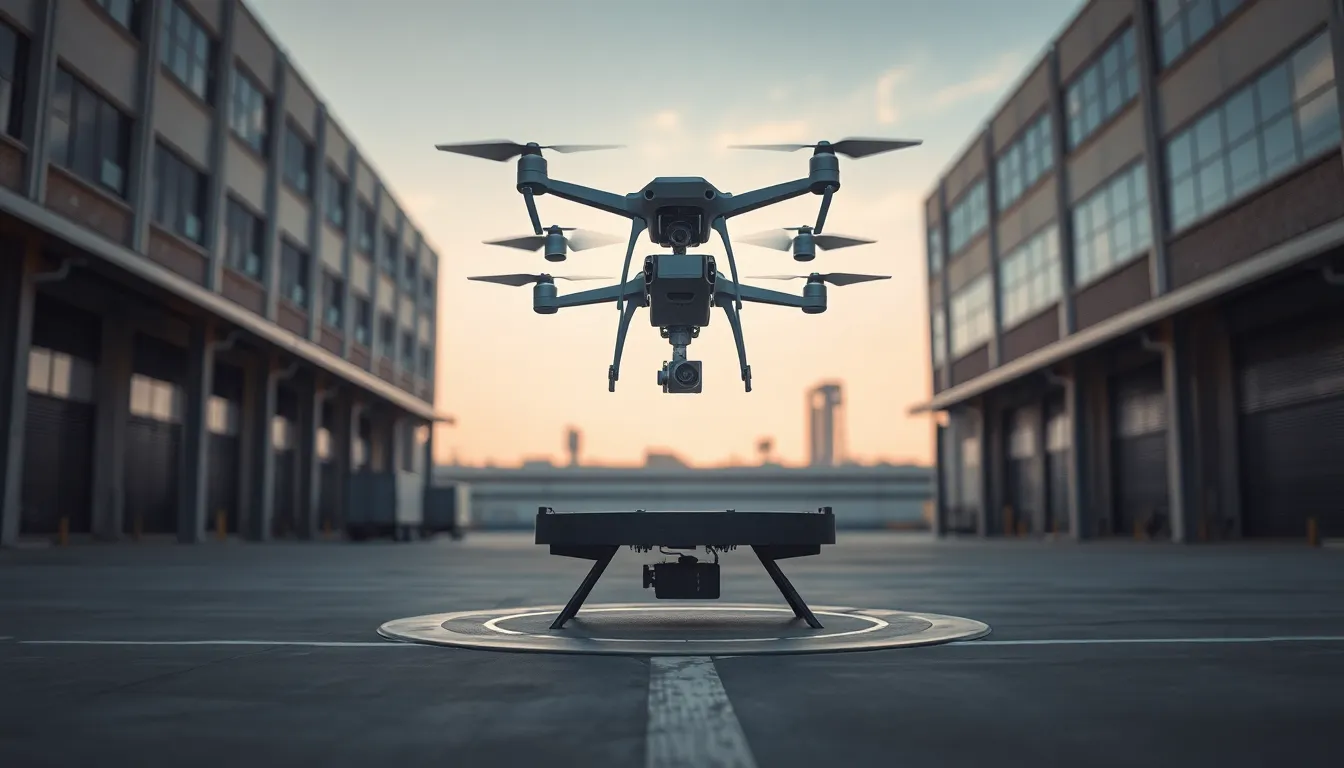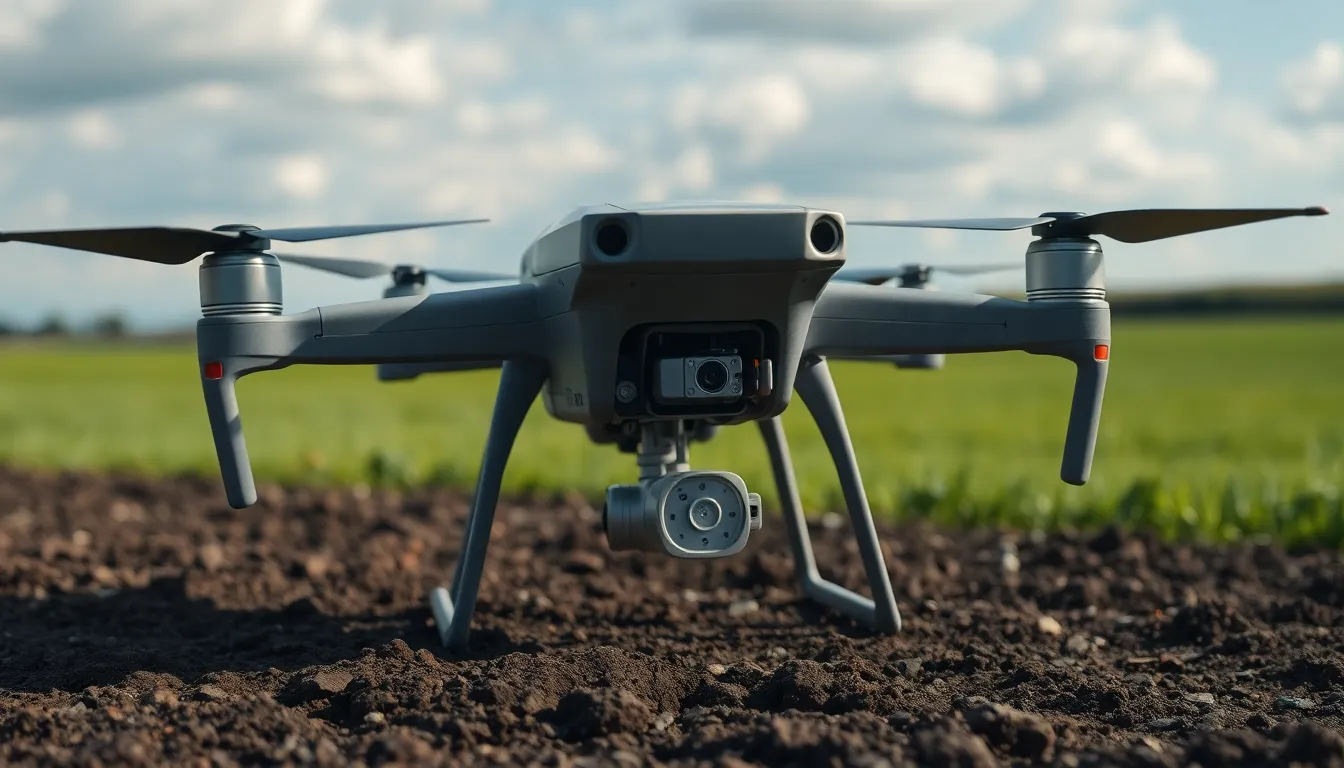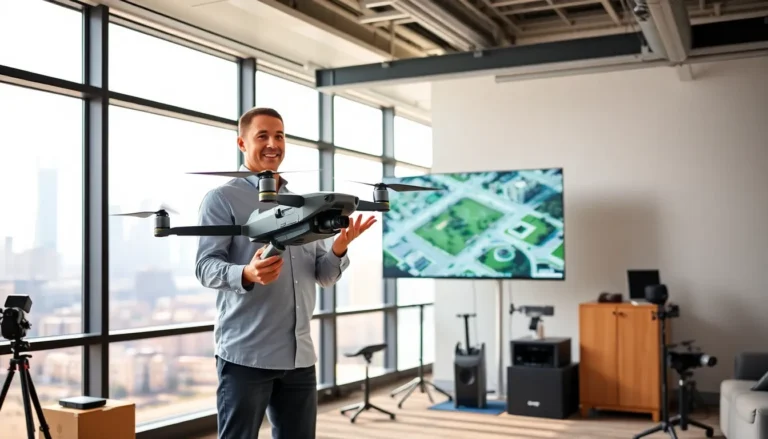In a world where drones are buzzing around like caffeinated bees, the need for reliable landing systems has never been more crucial. Imagine a drone gracefully descending like a superhero, landing perfectly without a scratch. Sounds dreamy, right? Well, that’s the magic of drone landing systems, turning what could be a chaotic crash landing into a smooth touchdown.
These systems are the unsung heroes of the drone world, ensuring that high-flying gadgets don’t turn into expensive paperweights on their way back to Earth. Whether it’s for delivery services, photography, or just showing off, understanding how these landing systems work can save time, money, and maybe even a few friendships. Dive into the fascinating realm of drone landing systems and discover how they keep the skies safe and the ground drama-free.
Table of Contents
ToggleOverview of Drone Landing Systems
Drone landing systems consist of advanced technologies designed to ensure smooth and safe landings. These systems utilize sensors, cameras, and GPS to accurately determine the drone’s position, making precise landings possible. For instance, optical flow sensors assess the ground environment, enabling real-time adjustments during descent.
Multiple types of landing systems cater to various drone applications. Precision landing systems enhance accuracy, which proves vital in delivery services where packages require exact placement. Automated landing systems streamline operations, particularly in applications involving robotics and agricultural drones, where human intervention occurs less frequently.
Safety remains a primary concern for drone operations. Reliable landing systems prevent crashes by providing essential data on terrain and obstacles. Many systems incorporate fail-safe features, ensuring drones can still land safely even if primary systems fail.
Flexibility in landing options also characterizes these systems. Whether landing on uneven terrain, rooftops, or designated pads, landing systems adapt to the environment, enhancing usability. Additionally, integration with other technologies, like obstacle avoidance systems, increases the safety and efficiency of landings.
Understanding drone landing systems reveals their critical role in various industries. As reliance on drones grows, investment in these technologies becomes essential to maximize operational effectiveness and ensure safety.
Types of Drone Landing Systems

Various drone landing systems exist to accommodate a wide range of applications and environments. By understanding these types, users can select the most suitable system for their specific needs.
Fixed Landing Systems
Fixed landing systems provide a consistent platform for drones to land. Commonly found at designated sites, such as warehouses or helipads, these systems often include landing pads equipped with sensors. These sensors assist in guiding drones during landing. Additionally, fixed systems are ideal for robotics and other industrial applications where precision is crucial. They facilitate efficient package delivery and ensure reliability, as the set landing area minimizes the risk of obstacles.
Mobile Landing Systems
Mobile landing systems offer flexibility by allowing landing in various environments. These systems can be transported to different locations as needed, making them suitable for agricultural and emergency response applications. Drones equipped with these systems navigate to landing zones in real-time, adapting to changing conditions. Advanced mobile systems often utilize GPS and vision-based technology for precision landings, enabling safe operation in diverse terrains. Their versatility enhances the overall functionality of drone operations by accommodating landing in remote or unpredictable areas.
Key Technologies in Drone Landing Systems
Understanding key technologies enhances the reliability and effectiveness of drone landing systems. These advancements ensure drones operate safely in various environments.
GPS and Navigation Systems
GPS plays a vital role in drone landing systems. They provide real-time positioning data, facilitating accurate landings. Navigational algorithms help interpret this data, calculating optimal descent paths. Systems utilize multiple satellites to enhance location precision, which is essential for urban and rural applications. Combining GPS accuracy with inertial navigation systems results in robust positioning, even when GPS signals weaken. The integration of advanced mapping services further assists in avoiding obstacles during landing. Ultimately, these technologies work together to support safe drone operations.
Sensor Technologies
Sensor technologies significantly contribute to the success of drone landing systems. Cameras detect surface conditions and obstacles, offering visual feedback for safe landings. Ultrasonic sensors measure distance, ensuring drones maintain the correct altitude as they approach the ground. LiDAR systems provide high-resolution mapping, allowing drones to assess terrain types. Collision avoidance sensors enhance safety by detecting nearby objects in real-time. Data from these sensors is processed using sophisticated algorithms to facilitate adjustments during landing. With these technologies, drones adapt seamlessly to different environments and landing scenarios.
Benefits of Advanced Drone Landing Systems
Advanced drone landing systems offer several key advantages that enhance operational efficiency and safety. First, accuracy in landings contributes significantly to successful operations, especially in logistics. Precise landing capabilities reduce delivery errors, ensuring packages reach their intended destinations without mishaps.
Safety improvements represent another crucial benefit. With integrated sensors and GPS technologies, these systems minimize crash risks by detecting obstacles and providing real-time terrain data. Enhanced awareness of surroundings leads to safer maneuvering during landing sequences.
Increased operational flexibility also plays a vital role. Mobile landing systems enable drones to adapt to various environments, whether in urban settings or rural landscapes. This adaptability proves essential for sectors like agriculture, where terrain can often vary dramatically.
Furthermore, time efficiency becomes evident with advanced landing systems. Streamlined landing processes speed up turnaround times, enabling drones to operate more effectively in high-demand scenarios. Quick landings contribute to improved workflow in industries relying on rapid deliveries or emergency services.
Cost savings emerge as well. By minimizing damages from crashes and optimizing delivery logistics, organizations can experience reduced operational costs. The initial investment in advanced technology often results in long-term financial benefits.
Finally, scalability serves as a crucial advantage. Advanced landing systems can grow alongside fleet expansions or new operational needs. This ensures long-term viability and adaptability in dynamic environments where drone usage continues to increase.
Challenges and Considerations
Multiple challenges arise in the development and implementation of drone landing systems. Safety remains a top priority as these systems must navigate diverse environments and avoid obstacles. Advanced sensor integration plays a crucial role in assessing landing conditions and adapting to unexpected variables.
Variability in weather conditions can impact drone landing accuracy. Rain, wind, and low visibility may hinder sensor effectiveness, requiring robust algorithms that adjust to fluctuating environments. Drones must also accommodate differing terrains during their landing processes. Uneven surfaces or unexpected obstacles necessitate advanced mapping capabilities and real-time analysis to evaluate landing suitability.
Regulatory compliance poses another challenge. Adhering to local regulations regarding airspace and landing site use can complicate operational logistics for drone fleets. Each jurisdiction may impose unique restrictions, demanding comprehensive knowledge from operators.
Affordability impacts the adoption of advanced landing systems. Budget constraints may restrict access to the latest technologies, resulting in slower integration across industries. Additionally, training personnel to utilize and maintain these systems effectively adds another layer of complexity.
Scalability becomes crucial as businesses expand their drone operations. Landing systems need to adapt seamlessly to growth, accommodating increased flight volumes and diverse applications. Coordination among various systems ensures smooth operational transitions, highlighting the importance of modular designs.
Ultimately, understanding these challenges enables industry stakeholders to make informed decisions. By prioritizing safety, adaptability, compliance, and scalability, organizations can enhance the effectiveness of their drone landing systems. Investing in research and development paves the way for innovative solutions that address existing limitations.
Future Trends in Drone Landing Systems
Emerging technologies are shaping the future of drone landing systems with significant advancements. Innovations in artificial intelligence enhance decision-making during landing, allowing drones to process environmental data in real time. Improved sensor technologies, like LiDAR and advanced imaging systems, increase detection accuracy and ensure safe landings in complex environments.
Integration with smart infrastructure is on the rise. Smart landing platforms equipped with communication technology facilitate seamless interaction between drones and landing zones. Such systems allow for real-time adjustments based on current conditions, improving landing accuracy and safety.
Autonomous landing capabilities are evolving. With precise GPS and sensor fusion, drones autonomously navigate to landing sites without human intervention. This autonomy benefits applications in agriculture, logistics, and emergency response, where timely landings are critical.
Standardization across the industry is expected to grow. Unified protocols for landing systems can enhance interoperability between various drone models and platforms. As the drone market expands, regulatory bodies will likely push for standardized technologies to ensure safety and efficiency.
Data analytics plays a crucial role in future developments. Analyzing landing patterns and environmental factors can inform design improvements, optimizing landing system performance. Robotics and drone manufacturers are investing in research to develop smarter algorithms that predict optimal landing strategies based on historical data.
Sustainability considerations are becoming essential. Eco-friendly materials and energy-efficient systems will be prioritized. Such approaches not only reduce environmental impact but also align with broader industry goals of sustainability and efficiency.
Overall, the next wave of drone landing systems will integrate advanced technologies, autonomy, and sustainability, pushing the boundaries of what’s possible in drone operations.
The evolution of drone landing systems is pivotal in shaping the future of drone operations. As technology advances, these systems are becoming more sophisticated and reliable, ensuring safe landings across various environments. The integration of AI and enhanced sensor technologies is set to revolutionize landing accuracy and efficiency.
Investing in these systems not only mitigates risks but also streamlines operations, offering significant time and cost savings. With an emphasis on safety and adaptability, the growth of drone landing systems aligns with the increasing demand for drone services. Embracing these innovations will ultimately lead to a safer and more efficient aerial landscape.





